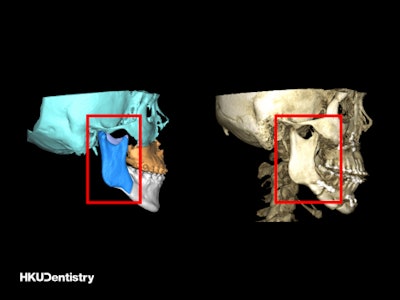
Sagittal split ramus osteotomy (SSRO) surgery improves the quality of life of "long jaw" patients better than intraoral vertical ramus osteotomy (IVRO) surgery, according to study findings published recently in Clinical Oral Investigations.
The results could improve care for patients with mandibular prognathism, wrote a team led by Dr. Mike Leung.
 HKU Dentistry oral and maxillofacial surgery researchers Dr. Mike Leung (left) and Natalie Wong, doctoral candidate.
HKU Dentistry oral and maxillofacial surgery researchers Dr. Mike Leung (left) and Natalie Wong, doctoral candidate.
“[Our] study confirms that SSRO appears to offer earlier improvement of the patients’ quality of life after orthognathic surgery because of better function," Leung and colleagues said in a statement about the results that were released on May 23 by the university.
Long jaw refers to the condition of having a longer face/more prominent jaw compared to typical measurements, investigators noted. It can lead to mandibular prognathism, or overdevelopment of the mandible, which can cause jaw joint pain and affect chewing function and/or facial aesthetics.
Mandibular prognathism is common in Hong Kong and Southern China, according to the researchers, and treatment typically consists of orthognathic surgery, which splits the jawbone and fixes it into a new position. Common surgical techniques to set the elongated lower jaw back are IVRO and SSRO (Clin Oral Investig, May 7, 2023, 27:4, pp. 1435-1448).
IVRO requires "intermaxillary fixation," which entails locking the upper and lower jaws with wire for six weeks. Patients consume a liquid diet during the fixation period. SSRO, however, uses titanium plates and screws, and patients’ jaw function is not impaired postsurgery.
Leung's team compared changes in 98 patients’ quality of life after undergoing IVRO or SSRO surgery. Forty-nine underwent IVRO surgery, and 49 received SSRO surgery. The researchers assessed patients' quality of life via two questionnaires that were administered up to two years after surgery. One survey asked patients to assess their oral health and the other questionnaire surveyed them about their physical and mental health.
During the early postsurgery recovery period, patients from both groups reported that their oral health-related quality of life was significantly better compared to their preoperative status and that it improved steadily. For patients’ physical and mental health-related quality of life, the team reported that "the burden of physical impact was bigger than the psychological impact in both groups in the early postoperative period," and that "social functioning, emotion, and mental health [were] specifically affected patients in the IVRO group." The findings suggest that for patients in the IVRO group, their mental health was continuously affected during the intermaxillary fixation period.
But SSRO had a slight edge when it came to patients' quality of life. The team stated that "patients who had SSRO had earlier improvement than those who had IVRO in the oral health-related quality of life and the physical and mental health-related quality of life, which showed signs of improvement as early as two weeks after the surgery," according to the university. The study illuminates the patient experience of the two surgical treatments, according to co-investigator and doctoral candidate Natalie Wong.
"On top of knowing the clinical outcomes, like stability and possible risks of the two procedures, this study reflected how the surgical procedures may impact [patients'] quality of life from different dimensions," she noted.



















